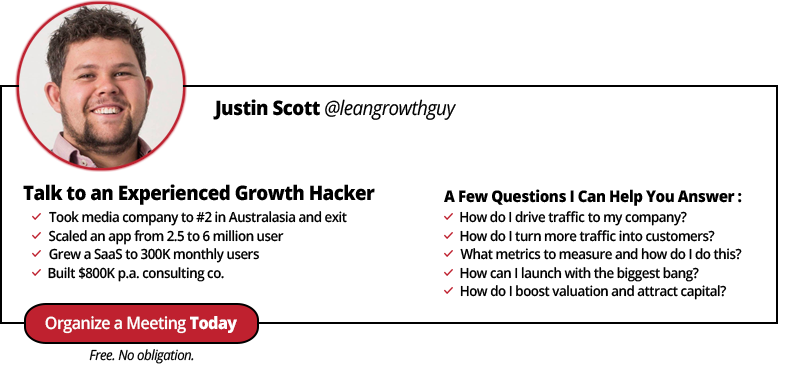Growth hacking is the art of mixing product characteristics, pertinent data and nimble marketing to create fast growth.
Traditional marketing, which uses mass media and messages that interrupt consumers, still works for established brands, and those with deep enough pockets to become one.
However, if you are a startup, you do not have the budget or time to employ traditional marketing. You must hack growth by looking for the leverage points that can catapult your company to the next level.
Growth Hacking Origins
The term “growth hacking†was originally coined by originally coined by Sean Ellis in 2010. In his Jul 26, 2021 article, “Where Are All The Growth Hackers?†Sean says, “A growth hacker is a person whose true north is growth.
Everything they do is scrutinized by its potential impact on scalable growth. Is positioning important? Only if a case can be made that it is important for driving sustainable growth (FWIW, a case can generally be made).
“The good news is that when you strip away everything that doesn’t have a direct impact on growth, a growth hacker should be easier to hire than a VP Marketing (or maybe an insider already has the needed skills). I’ve met great growth hackers with engineering backgrounds and others with sales backgrounds.â€Â
New VP Of Marketing
Blogger and entrepreneur Andy Chen, picked up on the theme in his April 27, 2021 post, “Growth Hacker Is the New VP Marketing,†saying, “The new job title of “Growth Hacker†is integrating itself into Silicon Valley’s culture, emphasizing that coding and technical chops are now an essential part of being a great marketer.
“Growth hackers are a hybrid of marketer and coder, one who looks at the traditional question of “How do I get customers for my product?†and answers with A/B tests, landing pages, viral factor, email deliverability, and Open Graph.
On top of this, they layer the discipline of direct marketing, with its emphasis on quantitative measurement, scenario modeling via spreadsheets, and a lot of database queries.
If a startup is pre-product/market fit, growth hackers can make sure virality is embedded at the core of a product. After product/market fit, they can help run up the score on what’s already working.â€Â
Not Enough Paying Customers
Growth Hacking is the result of a major problem for new products. Steve White said that no startup ever failed for lack of product developmentâ€â€they failed because they didn’t have enough paying customers.
In a recent speech at the Chicago Lean Startup Circle, Todd Wyder, serial entrepreneur and CEO of Pathfinder Software, asked the audience, “How do you accomplish the exponential growth needed to capture market share?”
He said the most difficult part of the startup is getting enough people engaged in your product. he solution is a growth hacker. “They combine marketing, customer development and data to find solutions,†he said. “The first up is customer acquisition, actually getting prospects to your site. Next is activation, getting them to sample your product, followed by retention which is getting them engaged and finally referral which is when happy customers refer new prospects.â€Â
Avoid Beta
Wyder explained that growth hackers do not “do beta.” What ends up happening is that product developers go into beta phase, and then continue to add features because they think that is what will save them. The opposite is what is actually happening. The entrepreneurs are adding features people don’t want, which accelerates their failure rate.
“You really just need to know what people want in your software. You can determine that by analyzing the analytics to see how often they return to your site, if they login, if they get confused etc,†Wyder said. “You do have to build a sales funnel. But don’t add more people in the top of the funnel if there are leaks in the bottom. Keep people that are in the funnel already engaged on your site before adding new prospects.â€Â
Always Be Testing
Growth hackers are always testing to determine what exactly people want. They want you to become engaged in their site. For example, Flickr wants you to log in, share photos and comment on photos. They want plenty of user interaction. They know that by getting engaged, you’re much more likely to become a long-term user of the site. Once you become a long-term user, the chances of you leaving are much lower.
Software entrepreneurs must determine which activities create the most stickiness. Wyder explained, “WuFoo is a form maker. They want people to make forms. If you haven’t been there in a while, they will not send an e-mail that says that they haven’t seen you in four months. That doesn’t work. Rather, they list all the new form features they have developed since you were there last.â€Â
Drive Toward Stickiness
He said you must drive them toward stickiness. Smart software vendors know the actions that their prospects have to take for them to become long-term clients. Look for the “one metric that matters,†the singular events that result in major stickiness.
For example, Dropbox knows that if you put the software on a device and upload one file, the chances are you will stick with them forever. Twitter suggests other people to follow because they know that is an engagement metric that will result in long-term customers. You must find those metrics which are meaningful for your particular audience.
Unfortunately, many companies do not do this. They believe the answer is to throw more prospects in the top of the sales funnel. However, those prospects never become engaged in the company, and they leave forever. One example of this is a company called Color, which picked up $40 million in venture capital, but did not determine what features were engaging their prospects, if any. Instead, they opted to spend money to get more prospects. There was no engagement, and the company ultimately folded.
Just Ask
One of the best ways to find out what potential customers like and don’t like about your product is to simply ask them. Wyder explains, “Ask customers why they don’t stick around. Ask them what they like, talk to them. Use e-mail, on-site chat, call them on the phone. Customers will talk to you- always.
Ask them what they need from you to keep using the application. Call the first 100 customers and ask them these types of questions. Entrepreneurs sometimes think they will be interrupting people. Don’t worry. They will always talk to you. People want to help.â€Â
One of the tricks to successful growth hacking is to get as narrow as possible. Segment your prospects. Alter your product to appeal to the best use cases. The way that consumers use your product may be very different from the way the founders originally intended. Successful companies are flexible, and alter their software to follow the needs of their customers.
Get Viral
One of the fastest ways to use growth acting is to leverage the power of another platform. For example, Airbnb was originally successful by placing ads on Craigslist, where they knew people that were looking for temporary housing could be found. Before Google bought them, YouTube found initial success when rock bands would embed their videos on their MySpace profiles.
Hotmail grew rapidly when they added a bottom signature that said, “PS, I love you. Click here to get your own Hotmail.†This strategy was very successful. Hotmail had over 12 million users at a time when the entire Internet had only around 70 million users total.
Growth Hacking is a delicate art. It takes an engineer’s love of numbers, a marketing executive’s creativity and the coding skills of a master programmer. The companies that can talk to their customers, find out what they really want in the product, and adapt quickly to meet that demand will be rewarded with rapid growth, rising sales and a secure long-term future.


